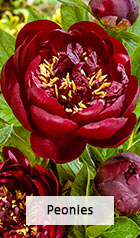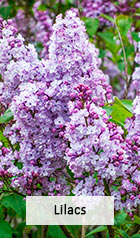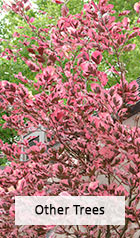- Fall Preview
- Perennials
Close X
Reliable color year after year.
- Bulbs
Close X
Fill your summer with blooms.
- Clematis & Vines
Close X
Provide ambiance and romance.
- Shrubs
Close X
Habitat, color & design possibilities.
- Trees
Close X
A gift for the next generation.
- Patio Orchard
- Fruits
- Tools & Décor
Close X
The right tools make gardening a pleasure.
- Spring Clearance
- Gardening Resources
Close X
Tips and tricks for easy, beautiful gardens.
Iris Rhizomes
Bright beauty in the spring garden.

A classic perennial, iris flowers are a showy staple for your home garden. The bright colors are sure to impress any onlooker, which is no surprise because the name is derived from the Greek goddess of rainbows. Today's iris flowers are available in an array of colors and patterns, including bold, solid tones, and multi-colored, extravagantly patterned displays. The plethora of color options allow gardeners to get creative with their displays. Plant one variety en masse, choose multiple varieties, or incorporate your iris flowers into perennial flower beds. Irises require hours of direct sunlight to bloom and excel when planted prominently along garden borders or within cut flower arrangements. Iris flowers also exhibit deer resistance and drought tolerance, making them a low maintenance perennial. Look for our reblooming bearded irises for sale to enjoy beautiful colors year-round. Or, opt for our dutch irises to grow alongside your garden greens. Whichever iris bulbs you choose this season, they're sure to be a pleasure to grow.
What are the different types of irises?
The iris family's name, Iridaceae, comes from the Greek word for rainbow. Not only do irises bloom in a rainbow of colors, this family includes plants of many shapes, heights and textures. In fact, over three hundred species of iris exist in today's horticultural landscape. The vast variety of the iris family allows you to choose the perfect iris for your garden. So, what makes bearded German irises different from other types of irises? Let's look at a few common divisions of irises.
Bulb iris versus rhizome iris:
Irises can be divided into two general groups—bulb irises and rhizome irises. Bulb irises grow from small bulbs, and include early spring species like Dutch irises and reticulata. Even though gardeners often talk about "iris bulbs," most irises grow from rhizomes, including German irises and beardless species of irises.
Bearded iris versus beardless iris:
German iris, or bearded iris, are the most popular iris in American gardens. It's easy to see why—German irises are tall and stately, available in nearly every imaginable color, and they're very easy to grow. Bearded irises feature standards, the upper, ruffled petals, and falls, the petals below the "beard" of the iris. The beard itself is a fuzzy patch at the base of each falls petal. The standards and falls are often two different colors, or feature variegated or two-tone petals.
Beardless irises include most other types of rhizome irises. Japanese irises feature flowing, butterfly-like petals. Louisiana irises also have a wide, flatter shape than their bearded counterparts. Siberian irises feature a symmetrical shape and attractive, grass-like foliage. Many other varieties of wild iris and species iris exist in this beardless group.
Types of German iris:
German irises are categorized according to their size. The American Iris Society breaks them into these six groups:
- Miniature Dwarf Bearded
- Standard Dwarf
- Intermediate Bearded
- Border Bearded
- Miniature Tall Bearded
- Tall Bearded
By mixing heights of German iris, you can absolutely create a garden filled exclusively with iris flowers. If you want to put your iris in multiple locations, you can place dwarf varieties in the front of beds or borders, and try tall bearded irises as accent plants.
When to plant iris bulbs:
Even though German iris bulbs are technically rhizomes, they perform best when planted in the fall. However, unlike tulips and daffodils, which need to be planted after the ground cools, irises can be planted in early fall, or even late summer. The evenings should be cool, but above freezing, at planting time.
When to transplant iris flowers:
Most gardeners divide irises every two to three years, to maintain the shape and health of their iris clumps. But, when is the best time to transplant iris flowers? Transportation is best planned during the early fall, around the same time as planting season for irises. By moving your iris rhizomes before cool weather sets in, you're giving them time to establish roots.
Transplanting irises is relatively easy. Just cut the leaves back to a few inches above the root clump. Pull the iris rhizomes up, and divide them with a clean spade or knife, being sure that each "new" rhizome includes a fan of leaves and a healthy set of roots. Discard any rotted or dried-out irises, then simply dig a hole in their new location and set the divided rhizomes.
When do irises bloom?
German irises have some of the longest bloom times in the iris world. German irises have a bloom period ranging from early spring into summer, giving your garden weeks of rainbow-hued gorgeousness. Check for specific bloom times for your selections—by mixing and matching varieties with different blooming periods, you'll extend the bloom season by a few weeks. Some irises, especially those in the dwarf families, rebloom in the fall, for an even longer and more impressive display.

































